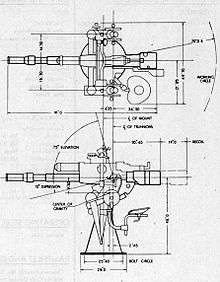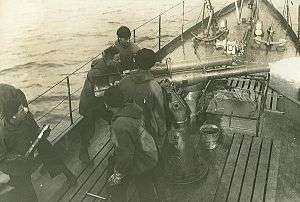3"/23 caliber gun
| 3"/23 caliber gun | |
|---|---|
|
A 3"/23-caliber gun being fired aboard the United States Navy submarine chaser USS SC-291 sometime between 1918 and 1920. | |
| Type | |
| Place of origin | United States |
| Service history | |
| Used by | US Navy |
| Wars | World War I |
| Production history | |
| Manufacturer |
|
| Variants | Mark 9, 13, and 14 |
| Specifications | |
| Weight |
|
| Length |
|
| Barrel length |
|
|
| |
| Shell | 16.5 lb (7.5 kg) |
| Caliber | 3-inch (76 mm) |
| Elevation | -15° to +65° or +75° |
| Traverse | 365° |
| Rate of fire | 8 – 9 rounds per minute |
| Muzzle velocity | 1,650 feet per second (500 m/s) |
| Effective firing range |
|
The 3"/23 caliber gun (spoken "three-inch-twenty-three-caliber") was the standard anti-aircraft gun for United States destroyers through World War I and the 1920s. United States naval gun terminology indicates the gun fired a projectile 3 inches (76 mm) in diameter, and the barrel was 23 calibers long (barrel length is 3" x 23 = 69" or 1.75 meters.)[1]
Description

The built-up gun with vertical sliding breech block weighed about 531 pounds (241 kg) and used fixed ammunition (case and projectile handled as a single assembled unit) with a 13-pound (6 kg) projectile at a velocity of 1650 feet per second (500 m/s).[2] Range was 10100 yards (9235 meters) at 45 degrees elevation.[2] Ceiling was 18000 feet (5500 meters) at the maximum elevation of 75 degrees.[2]
History
The 3"/23 caliber cannon was the first purposely-designed anti-aircraft cannon to reach operational service in the US military, and was a further development of a 1 pounder cannon concept designed by Admiral Twining to meet the possible threat from airships being built by various navies.[3]
A partially retractable version was mounted as a deck gun on the US L-class, M-1 (SS-47), AA-1 class, and O-class submarines.
When World War II began, the 3"/23 caliber gun was outdated, and surviving United States destroyers built during the World War I era that were armed with the 3"/23 caliber were rearmed with dual-purpose 3"/50 caliber guns. Where there was no air threat during World War II, the 3"/23 caliber gun was employed in the surface to surface role for use against submarines, and was mounted on submarine chasers, armed yachts, and various auxiliaries.[2] Some major warships carried 3"/23 caliber guns temporarily while awaiting installation of quad 1.1"/75 caliber guns.[2]
The 3"/23 caliber gun was mounted on:
- United States L-class submarines
- USS M-1 (SS-47)
- AA-1-class submarines
- United States O-class submarines
- Caldwell-class destroyers[4]
- Wickes-class destroyers[4]
- Clemson-class destroyers[4]
- SC-1-class submarine chasers
- SC-497-class submarine chasers (varied over time)
Notes
References
- Campbell, John (1985). Naval Weapons of World War Two. Naval Institute Press. ISBN 0-87021-459-4.
- Fahey, James C. (1939). The Ships and Aircraft of the U.S. Fleet, War Edition. Ships and Aircraft.
- Fairfield, A.P. (1921). Naval Ordnance. The Lord Baltimore Press.
- Lenton, H.T.; Colledge, J.J. (1968). British and Dominion Warships of World War II. Doubleday and Company.
- DiGiulian, Tony Navweaps.com 3"/23 caliber gun
External links
| Wikimedia Commons has media related to 3"/23 caliber gun. |
